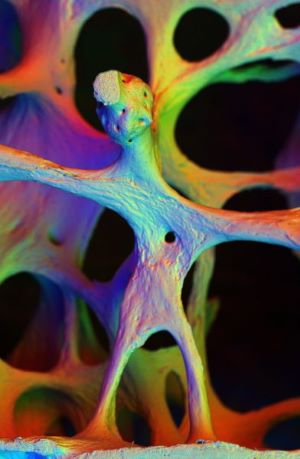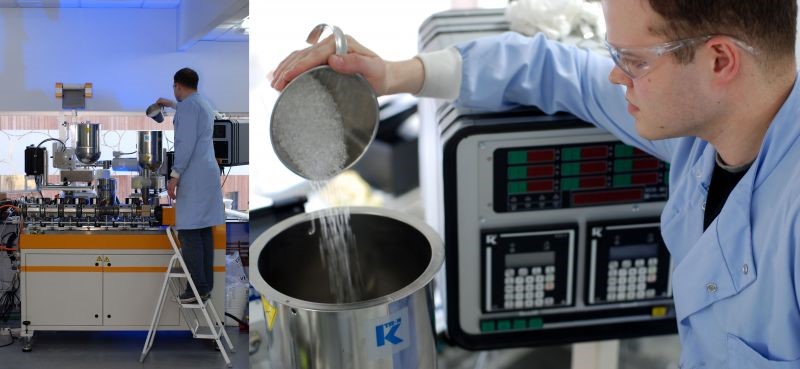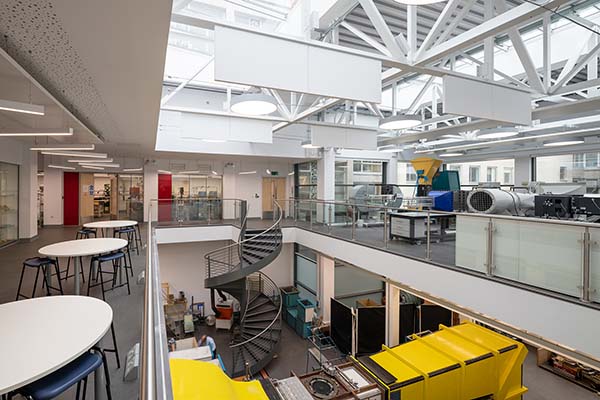Facilities to inspire and support your learning
With significant investment in our highly-regarded facilities, you'll be able to explore your subject matter and get sought-after practical experience.
The School of Engineering and Materials Science has recently invested over £30m in new laboratories and refurbishments to provide a suite of state-of-the-art facilities.
 We have world-class processing facilities, including the NanoVision Centre for Advanced Microscopy, combining high resolution imaging with structural, chemical and mechanical analysis.
We have world-class processing facilities, including the NanoVision Centre for Advanced Microscopy, combining high resolution imaging with structural, chemical and mechanical analysis.
Queen Mary’s NanoVision Centre is a multimillion-pound, state-of-the-art microscope unit that brings together the latest imaging technologies to open-up new avenues for cutting-edge research.
This multidisciplinary facility is unparalleled in the UK, combining high resolution imaging with structural, chemical and mechanical analysis. The Centre will underpin research by advancing the frontiers in materials science, cell and molecular sciences, structural biology, solid state physics and the earth sciences.
Nanoforce Technology Limited was established in 2005, it is an open-door industry-facing research and development company committed to delivering state of the art material solutions based on advanced processing technologies. We provide unique solutions for a wide range of topics including:
- High-performance ceramics processing: Spark plasma sintering of structural and functional ceramics, and metal alloys
- Synthesis and processing of materials in strong magnetic fields: Synthesis of non-equilibrium phases, hierarchical and textured microstructures
- Advanced polymers and composites processing: Compounding, electrospinning, coating, printing, micro-encapsulation and smart textiles
- Computational modelling: Theoretical and numerical modelling for the dynamic failure of hybrid micro and nano-reinforced materials
- Materials characterisation: Mechanical and chemical testing, thermal analysis, conductivity measurement and spectroscopic analysis
Over the years, Nanoforce has created a strong strategic partnership with governments, industry and other research organisations to identify market requirement and to transform scientific expertise into diverse industrial applications in aerospace, creative industry, environmental sustainable materials, healthcare, renewable energy, energy storage and bio-technology.

The Whitehead Aeronautical Laboratory contains a large number of wind tunnels that are being used for teaching, undergraduate projects, and research activities. In addition to the wind tunnels themselves these laboratories contain a large variety of flow measurement and visulisation tools including:
- Pressure probes
- Flow Visualisation tools such as smoke, oil and schlieren system
- State-of-the-art image processing techniques for obtaining qualitative and quantitative information about the flow field
- Hot-Wire Anemometers for turbulence measurements
- Advanced optical flow diagnostic tools such as Particle Image Velocitemetry (PIV) and Laser Doppler Velocimetry (LDV)
- Direct force and moment measurement using three and six-component balances
- Noise measurement devices.

We have three high speed wind tunnels covering a range of Mach numbers from M=0.3 to three times speed of sound, M=3.0. The high-speed facilities are used for undergraduate teaching, laboratory practicals and research projects in aerospace engineering.
These wind tunnels are also being used for research in areas such as:
- Aerodynamics of Jet Engine Turbine Blades at Transonic Speeds
- Control of Shock-Boundary Layer Interactions at Transonic-Supersonic speeds
- Cavity Flows, base drag etc.
We also have five low speed wind tunnels. Four of these are regularly used by undergraduate students working on topics such as aerodynamics of: airships, wings, road & sport vehicles, flow control for the reduction of drag, jet engine compressor, turbine blades and wind energy, etc. The fifth wind tunnel is a unique research facility in UK which is used for understanding the stability of laminar flows and its active control. Several external organisations such as Airbus, US air force etc. are involved in using this facility.
Our acoustic research rig was designed and built for conducting research in the noise production of supersonic jet engines and nozzles. The existing nozzles are designed for transonic and supersonic operations. Aspects of flow control methods in reducing the noise signature of a jet engine exhausts are also being studied. Our anechoic chamber is equipped with sensitive noise measurement microphones, and optical flow measurement systems.